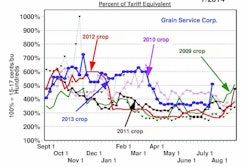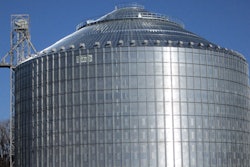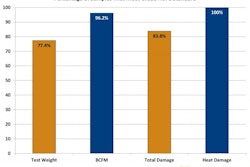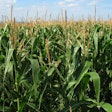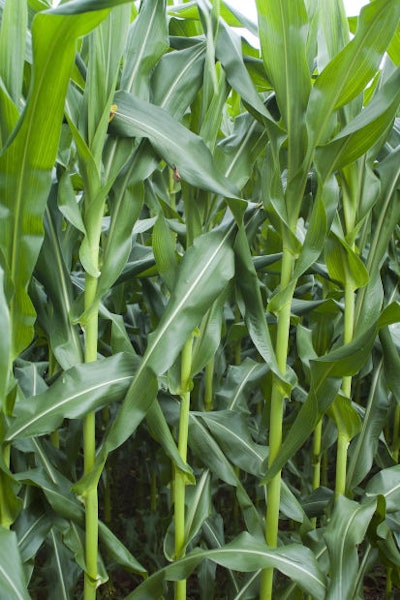
The U.S. average corn yield was record large in 1985, 1986, and 1987 and established new highs five times in the succeeding 26 years. Similarly, the U.S. average soybean yield was record large in 1985 and established new highs eight times in the succeeding 26 years. The most recent record yield was in 2009 for both crops. Average yields were below trend value in each of the past four years.
Expectations for the U.S. average corn and soybean yields this year have increased in recent weeks. Corn planting got off to a slow start, much like last year. Even though progress accelerated in May, more than the average percentage of the crop was planted after the third week of May. Based on the USDA's weekly Crop Progress report, an estimated 23 percent of the corn acreage in the 18 major corn producing states was planted after May 20, compared to the 1986 through 2013 average of 15 percent. More than the average portion of the corn acreage was planted late in five of the past seven years Most of the late planting this year occurred in northern and far eastern corn producing states. Yield potential is reduced for corn planted after the second or third weeks of May, all other conditions equal. However, weather conditions over the past month have been generally favorable for corn emergence and development, resulting in high yield expectations in spite of more than the usual amount of late planting. The USDA acknowledged these conditions in the June 11 WASDE report as the reason for keeping the 2014 yield projection at a record 165.3 bushels per acre.
The USDA's weekly ratings of corn conditions have also supported high yield expectations. As of June 8 (23rd week of the year), 75 percent of the crop in the 18 major corn producing states was rated in either good or excellent condition. In the previous 28 years (excluding 1995 when ratings were not yet available due to extremely late planting) an average of 66 percent of the crop was rated in good or excellent condition at the end of the 23rd week. The portion of the crop rated in good or excellent condition was higher than this year in only five previous years. Crop condition ratings tend to decline as the growing season progresses and early season ratings are not a good indicator of either final ratings or the U.S. average yield. Still, the current high ratings along with a mostly favorable weather outlook are keeping yield expectations high. The major concerns in the near term center on deteriorating conditions in areas that have received excessive rainfall in recent weeks. The effect of flooding and ponding may begin to be revealed in the crop condition ratings to be released today. Those concerns are legitimate, but are likely outweighed by the beneficial impact of favorable weather in most areas.
Soybean planting also started slowly this year, but a larger than average portion of the crop was planted before the end of May. For the week ended June 8, 74 percent of the crop in the 18 major soybean producing states was rated in either good or excellent condition. Soybean condition ratings were reported for the 23rd week of the year in 17 of the 28 years from 1986 through 2013. On average, only 62 percent of the crop was rated in good or excellent condition for that week. The previous record high rating was 73 percent in 2010. Soybean crop condition ratings tend to decline even more than for corn as the growing season progresses and early season ratings are not always a good indicator of the final U.S. average yield. Recent and upcoming heavy rainfall in some areas will likely begin to be reflected in deteriorating ratings, but yield expectations remain high.
The critical part of the growing season for corn and soybeans is still to come. The record yields of 2004 and 2009 were the result of ample summer rainfall and cooler than average summer temperatures. A repeat of those conditions this year could result in an average corn yield above the record yield projected by the USDA. The 2009 average yield, for example, was four bushels above the 2004 average. A similar jump from 2009 to 2014 would result in an average of 168.7 bushels. Based on the current projection of harvested acreage, such a yield would produce a crop 286 million bushels larger than currently projected by the USDA. For soybeans, the 2009 record yield was 0.9 bushels above the previous record of 2005. A similar jump from 2009 to 2014 would result in an average yield of 44.9 bushels, which is actually 0.3 bushels lower than the current USDA projection. Based on the current projection of harvested acreage, such a yield would produce a crop about 24 million bushels less than forecast by the USDA.
While it is too early to be confident of U.S. corn and soybean yield potential, the markets are clearly anticipating very large crops, particularly for corn. Prices will likely remain under pressure as long as conditions continue to point to average yields above trend value.
Issued by Darrel Good
Department of Agricultural and Consumer Economics
University of Illinois
Also available at:
http://farmdoc.illinois.edu/marketing/weekly/html/061614.html



